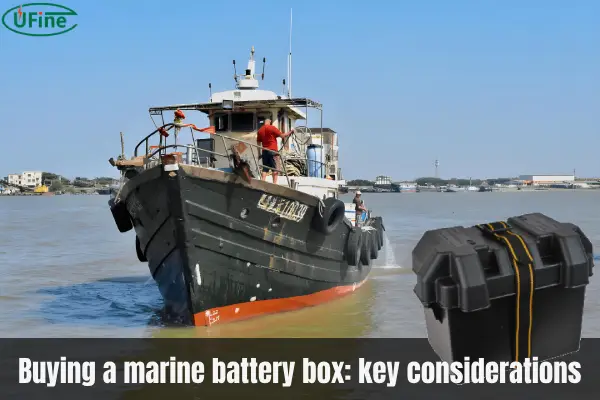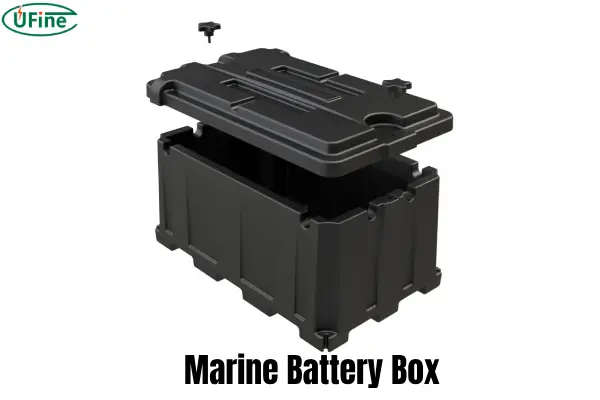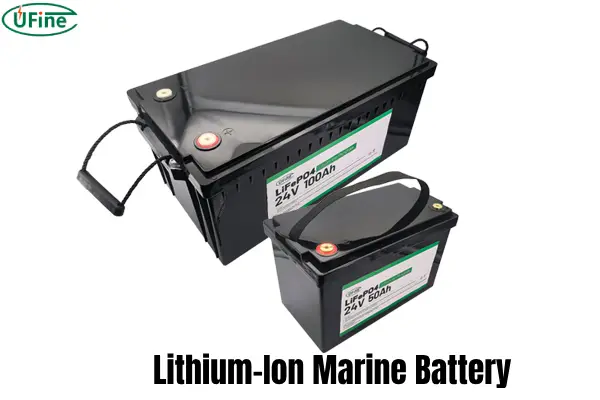Part 1. Composition
Imagine your battery as the heart of your boat, quietly pumping energy to power your essential electronics and amenities. Just like the human heart, it needs a sturdy and reliable protective system – enter the marine battery box. Let’s explore the key components that make these boxes the ultimate guardians of your power supply:
Durable Enclosure: The foundation of the marine battery box is its rugged enclosure, engineered to withstand the relentless onslaught of saltwater, moisture, and impact. Commonly constructed from corrosion-resistant materials like reinforced plastic, fiberglass, or marine-grade aluminum, these enclosures are designed to shield your battery from the elements and keep it securely in place, even in the face of choppy waves and turbulent conditions.
Ventilation System: Batteries, especially lead-acid types, can release potentially flammable gases during operation and charging. Marine battery boxes address this safety concern by incorporating strategically placed ventilation holes or channels. These allow the safe and controlled release of these gases, preventing dangerous buildups and ensuring a well-circulated environment for your battery.
Secure Lid or Cover: The lid or cover of a marine battery box plays a crucial role in maintaining the integrity of the enclosure. Featuring robust seals and locking mechanisms, these components create a barrier against water, debris, and other external threats, safeguarding your battery from the harsh marine environment.
Mounting Brackets and Handles: Securing the battery in place is essential for maintaining a stable power source, especially during choppy waters or rough terrain. Marine battery boxes are equipped with heavy-duty mounting brackets and handles, ensuring your battery stays firmly in place and is easily transportable when necessary.
Additional Features: Some advanced marine battery boxes go beyond the basics, offering a range of additional features to enhance functionality and safety. These may include built-in fuses or circuit breakers to protect against overcurrent, integrated chargers for convenient power management, and even temperature monitoring systems to ensure your battery operates within its optimal range.
Part 2. Function
While the primary function of a marine battery box is to protect your battery, its importance extends far beyond just safeguarding your power source. These ingenious enclosures play a crucial role in maintaining the overall safety, efficiency, and longevity of your boat’s electrical system. Let’s explore these vital functions in greater detail:
Environmental Protection: The marine environment is notoriously harsh, with saltwater, moisture, and UV radiation constantly threatening the integrity of your battery. A well-designed marine battery box acts as a shield, shielding your power source from these damaging elements and ensuring it remains in peak condition, even in the most punishing conditions.
Safety Precautions: Batteries can pose serious safety risks, from the potential for fire hazards to the dangers of acid spills and electrical shocks. Marine battery boxes address these concerns by containing any potential leaks or spills, preventing accidental contact with live terminals, and even incorporating features like ventilation systems to mitigate the buildup of flammable gases.
Improved Reliability: By protecting your battery from the elements and securing it in place, marine battery boxes help maintain a stable and consistent power supply. This enhanced reliability is crucial for powering essential systems on your boat, from navigation equipment to critical emergency devices, ensuring you can navigate the waters with confidence.
Extended Battery Lifespan: The harsh marine environment can take a significant toll on your battery’s lifespan, leading to premature degradation and the need for frequent replacements. Marine battery boxes, with their robust construction and protective features, help extend the life of your battery by shielding it from damaging conditions and preventing accelerated wear and tear.
Organizational Benefits: With their secure, compartmentalized design, marine battery boxes keep your battery terminals organized and easily accessible, simplifying maintenance and troubleshooting. This streamlined organization can also help prevent accidental short circuits or other electrical issues, further enhancing the overall safety and reliability of your boat’s power system.
Part 3. Type
Just as boats come in a wide variety of shapes and sizes, so too do the marine battery boxes designed to protect their power sources. Understanding the different types of boxes and their unique features can help you make an informed decision when selecting the perfect one for your boat. Let’s explore the key categories:
Standard Marine Battery Boxes: These are the most basic and widely available options, offering essential protection for your battery against the elements. Typically constructed from durable, corrosion-resistant materials like reinforced plastic or fiberglass, these boxes provide a secure enclosure, ventilation, and mounting capabilities to keep your battery safe and secure.
Heavy-Duty Marine Battery Boxes: For boats that experience particularly rugged conditions or carry larger, high-performance batteries, heavy-duty marine battery boxes are the ideal choice. Engineered with thicker, more robust materials and enhanced structural integrity, these boxes are designed to withstand intense impacts, extreme temperatures, and the relentless assault of saltwater and moisture.
Ventilated Marine Battery Boxes: Some battery types, such as lead-acid, can release potentially hazardous gases during operation and charging. Ventilated marine battery boxes address this safety concern by incorporating advanced ventilation systems, ensuring the controlled release of these gases and maintaining a well-circulated environment for your battery.
Lithium-Ion Marine Battery Boxes: As lithium-ion batteries become increasingly popular in the boating industry, specialized marine battery boxes have emerged to cater to their unique requirements. These boxes often feature advanced temperature monitoring systems, balancing circuits, and other safety features to optimize the performance and lifespan of these high-energy batteries.
Modular Marine Battery Boxes: For boats with complex power systems or the need for flexibility, modular marine battery boxes offer a customizable solution. These boxes can be configured to accommodate multiple batteries, allowing users to tailor the layout and organization to their specific needs, while still maintaining the essential protective features.
Part 4. Price
The price of a marine battery box can vary significantly depending on its size, materials, features, and brand. Here’s a general overview of price ranges:
-
Basic Models: These models typically cost between $50 and $150 and offer essential protection for your battery. They are made from durable plastic or fiberglass and feature ventilation holes.
-
Advanced Options: These models can cost between $150 and $500 and offer additional features like built-in chargers, battery management systems, or temperature monitoring. They are often made from higher-quality materials and may have a more robust construction.
-
Custom Boxes: If you need a battery box with specific dimensions or features, you can have one custom-made. Custom boxes can be more expensive, but they offer the advantage of being perfectly tailored to your needs.
Part 5. Do I need a marine battery box?
Now that you’ve gained a deeper understanding of marine battery boxes and their importance, the question remains: do you truly need one for your boat? The answer lies in a careful consideration of your specific needs, operating environment, and battery requirements. Let’s explore the key factors to consider:
Battery Type: The type of battery you use in your boat can be a significant factor in determining the necessity of a marine battery box. Lead-acid batteries, for example, are more prone to leaks and gas emissions, making a ventilated battery box a critical safety measure. In contrast, sealed or absorbed glass mat (AGM) batteries may not require the same level of enclosure protection.
Operating Environment: The conditions in which you primarily use your boat can also influence the need for a marine battery box. If your vessel is frequently exposed to saltwater, harsh weather, or other environmental stressors, a durable battery box can provide invaluable protection and prevent premature battery degradation.
Battery Location: The placement of your battery within the boat can also be a consideration. Batteries located in high-traffic areas or in close proximity to flammable materials may benefit from the added safety and containment provided by a marine battery box.
Battery Size and Weight: Larger or heavier batteries can pose challenges in terms of secure mounting and transportation. A marine battery box with sturdy brackets and handles can help ensure your battery remains firmly in place and is easily movable when necessary.
Safety Concerns: If you have concerns about the potential hazards associated with your boat’s battery, such as the risk of acid spills or electrical fires, a marine battery box can offer an added layer of protection and peace of mind.
Part 6. Buying a marine battery box: key considerations

With a firm understanding of the diverse world of marine battery boxes, it’s time to dive into the decision-making process of choosing the right one for your boat. Whether you’re a seasoned boater or a newcomer to the marine life, these key considerations will guide you towards the perfect battery box solution:
Battery Size and Compatibility: The first and most crucial step is ensuring the marine battery box you select is compatible with the specific size and dimensions of your boat’s battery. Carefully measure your battery and cross-reference the manufacturer’s specifications to find a box that provides a snug, secure fit.
Material and Durability: As we’ve discussed, the marine environment can be harsh and unforgiving. Choose a battery box constructed from high-quality, corrosion-resistant materials like reinforced plastic, fiberglass, or marine-grade aluminum to ensure long-lasting protection.
Ventilation System: Proper ventilation is essential for maintaining a safe and healthy environment for your battery. Look for boxes with strategically placed ventilation holes or channels that allow for the controlled release of gases while preventing the ingress of water or debris.
Security and Mounting: Secure mounting is critical to prevent your battery from shifting or becoming dislodged during rough seas or turbulent conditions. Examine the box’s mounting brackets, handles, and locking mechanisms to ensure a stable, reliable, and easily transportable solution.
Additional Features: Depending on your specific needs and preferences, you may want to consider marine battery boxes with additional features like built-in fuses, circuit breakers, chargers, or temperature monitoring systems. These advanced capabilities can enhance the overall safety, convenience, and performance of your power system.
Brand Reputation and Warranty: When making a significant investment in a marine battery box, it’s essential to research the manufacturer’s reputation for quality, reliability, and customer support. Look for boxes backed by a robust warranty that provides added peace of mind and protection for your purchase.
Part 7. How long can the battery be kept in the marine battery box?
A marine battery box, when properly maintained, can last for many years. However, its lifespan depends on several factors:
-
Material Quality: The materials used in the battery box’s construction play a significant role in its durability. High-quality materials, like corrosion-resistant metals or UV-resistant plastics, will withstand the elements and last longer.
-
Environmental Conditions: The environment in which the battery box is used can impact its lifespan. Exposure to harsh weather conditions, extreme temperatures, or corrosive elements can accelerate wear and tear.
-
Usage and Maintenance: Regular inspection, cleaning, and proper maintenance can extend the lifespan of a marine battery box. Addressing any issues promptly, such as corrosion or loose connections, can prevent further damage and ensure continued safety and reliability.
By understanding the critical role of marine battery boxes and the factors to consider when selecting the perfect one for your needs, you can rest assured that your boat’s power source is secure, reliable, and ready to take on the challenges of the open water. So, whether you’re an experienced boater or just setting sail, embrace the peace of mind that comes with mastering marine battery boxes.
Related Tags:
More Articles

How High-Quality Lithium Battery Cells Are Made: A Comprehensive Guide
High-quality lithium battery cells stand out for their performance, reliability, and safety. Learn what sets them apart in materials, manufacturing, and testing
Comparing Mechanical Batteries and Lithium Batteries: Which Is Right for Your Application?
Explore the differences, advantages, and limitations of mechanical and lithium-ion batteries to find the best solution for your needs.
Exploring EV Battery Safety
Is your EV battery safe? Explore how EV battery safety works. Understand the role of battery cells and safety layers to protect your vehicle. Read more now!
What Type of Battery is Blade Battery? Unveiling Its True Features
Discover the key features of BYD's Blade Battery. Learn how it stands out in the market. Click to uncover its unique benefits now.
How Much Copper Goes into a Lithium-Ion Battery?
Copper is essential in lithium-ion batteries, powering devices from smartphones to EVs. How much copper is used? Let's explore the details.





